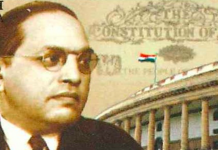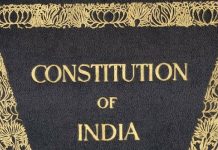This article was written by Sahaja and has been further updated by Shafaq Gupta. In this article, we will talk about the 104th Constitutional Amendment Act in detail. The article will highlight the significance of various previous amendments that finally led to the 104th Constitutional Amendment. We will further discuss the criticisms faced in light of this amendment. Through this article, we will also gain knowledge about the recent developments on reservations for Scheduled Castes (SC) and Scheduled Tribes (ST).
Table of Contents
Introduction
There is no denying that the Constitution of India, 1950, is the supreme law of the land in India. It is an ever-evolving document, so dynamic and inclusive in all aspects. It transforms itself according to the changing needs of society. It has been amended several times to find a solution to contemporary problems. This Constitution serves as a repository of society’s fundamental political values. Article 368 of the Constitution of India provides power to the Parliament to amend the Constitution and also lays down the procedure for doing so.
Do you all want to know about an important amendment that highlights India’s approach to representation in the legislature? The 104th Amendment Act of the Indian Constitution talks about that only. It was passed in 2019 and came into force on 25th January, 2020. It talks about the issue of reservation related to various social castes such as Scheduled Castes, Scheduled Tribes, and Anglo-Indians. It strongly demonstrates a will to uphold the inclusivity of the Constitution along with making adjustments for the changing societal needs.
Through this article, we will make an effort to learn about this amendment comprehensively. What was the need for this amendment? What other amendments are related to it? Or what is the historical background of the reservation related to those particular social castes? This article will cover every aspect of it.
Background of the 104th Constitutional Amendment Act
Let us first start by understanding the meaning of the word ‘reservation’. Reservation is an affirmative action taken by the government of the country. It is usually done to uplift the socially and educationally backward communities. Moreover, it also provides them with a platform to represent themselves.
Reservation can also be referred to as positive discrimination done to provide preferential treatment to certain backward communities such as Scheduled Castes and Scheduled Tribes. It is made possible by reserving seats for them in educational institutions, government jobs, and other areas.
Caste-based reservations are made to advance underprivileged groups and provide them with social equity. It is considered necessary since there is a huge amount of structural inequality and discrimination based upon the ancient caste system in Indian society.
To resolve such inequality and discrimination, which is present even today in our Indian society, the 104th Amendment to the Constitution extended the period of reservation for Scheduled Castes and Scheduled Tribes for another ten years till 2030. It was a much-needed step required to ensure social equity.
Historical background of the reservation
From where did this system of reservation even start? Let us see about it. The birth of the present reservation system can be traced back to India’s long-standing caste system. Earlier, the people were divided into upper and lower castes. So, reservation as a policy was adopted by the government of India to eradicate the historical injustices perpetrated by the so-called “upper castes”. Many “lower castes” in India were isolated from the mainstream decision-making process. May it be regarding administration or education, discrimination was done everywhere. This seriously hampered their development.
In 1822, William Hunter and Jyotirao Phule proposed the caste system for the first time in India. A few years later, Shahu Maharaj of Kolhapur expanded it. He instituted the system of educational reservation for non-Brahmins and the members of the lowest socio-economic groups. On 16th August,1932, the British Prime Minister, Ramsay Macdonald, delivered the ‘Communal Award’. The communal award established the reservation system that persists today. It provided for the establishment of separate electorates for different communities such as Muslims, Sikhs, Indian Christians, Anglo-Indians, Europeans, Dalits, etc.
After months of discussions, M.K. Gandhi and Dr. B.R. Ambedkar signed the ‘Poona Pact’ in 1932. It established a unified Hindu electorate with specific limitations. The number of seats reserved for the oppressed people was doubled under the Poona Pact as compared to the ‘Communal Award’. A large number of significant programs were also implemented after the independence for Scheduled Castes (SCs), Scheduled Tribes (STs), and Other Backward Castes (OBCs).
As per Article 340 of the Constitution, the Mandal Commission was established by the Indian government in 1979. The commission worked under the guidance of B.P. Mandal. Their main aim was to identify the socially and economically backward castes among Hindus as well as non-Hindus. Then, it had to recommend various solutions for their advancement. In its report, it stated that the OBCs made up around 52% of the population.
Thus, they were of the opinion that about 27% of the government jobs in India should be reserved for them. Initially, the SC/ST reservation system was approved only for a duration of ten years. However, it soon became evident that in order to address the problem of social discrimination, the reservation system was still required.
After studying the history of the reservation system in India, let us have a look at the latest amendment related to it.
One Hundred and Fourth Constitutional Amendment, 2019
What was the 104th Constitutional Amendment Act of 2019 all about? What all changes were made by it? What was the purpose behind introducing such changes? Let us discuss it.
The procedure followed for this amendment
It was introduced by Ravi Shankar Prasad, Minister of Law and Justice, in the Lok Sabha on December 9, 2019. An attempt was made to amend Article 334 of the Constitution. Finally, the Bill was passed by the Lok Sabha on December 10, 2019. There were 355 votes in favour of it and 0 votes against it. The bill was then introduced in the Rajya Sabha. There, it received 163 votes in favour and 0 votes against it. Hence, it was also passed by the Rajya Sabha on December 12, 2019.
On January 21, 2020, the amendment received the assent of the President of India, Ram Nath Kovind. The very next day, it got published in the official Gazette of India a came into effect on January 25, 2020.
Changes brought by this amendment
An amendment was made to Article 334 of the Indian Constitution. It further extended the deadline for a period of ten years until 26 January 2030 for the seats reserved for members of Scheduled Castes and Scheduled Tribes in the Lok Sabha and legislative assemblies of the state.
At present, the whole of India is divided into 543 constituencies to elect members to the Lok Sabha. According to the Delimitation Commission Report, 2008, 412 seats are for general, 84 seats are reserved for Scheduled Castes and 47 seats for the Scheduled Tribes. Earlier, it was 79 and 41 for Scheduled Castes and Scheduled Tribes, respectively.
However, the amendment ceased the reservation of seats for Anglo-Indians and did not extend the period of reservation of the two Lok Sabha seats reserved for members of the Anglo-Indian community. So, it abolished the practice of nominating two members belonging to the Anglo-Indian community to the Lok Sabha by the President of India, on the recommendation of the Prime Minister of India.
Reason/Purpose behind the amendment
The legislature is also bound by the law. It has to give proper reasons for its decisions. After all, amending the Constitution of India is a big thing as it would affect the lives of the citizens.
Ravishankar Prasad clearly provided the reason behind this amendment in the statement of objects and reasons. He clearly stated the fact that the Scheduled Castes and Scheduled Tribes have made significant progress in the last 70 years. But despite this progress, the factors that influenced the Constituent makers while making provisions for reservation of seats are still the same. Therefore, to maintain the Constitution’s inclusive character, as envisioned by the founding fathers, it was necessary to make an amendment.
As we all know India has become a global leader in promoting world peace. We have come a long way. There is a need to adapt to the changing times and progressively move towards a more generic ecology. The elimination of the reservation system for the Anglo-Indian community was by this.
The other reasons behind this amendment are mentioned below.
- First of all, the community has made great strides and established itself.
- Secondly, the population of Anglo-Indians has shrunk so low that there are even less than 500 people who identify themselves as belonging to that community.
- Thirdly, it allows the nation to move forward and let go of its historical burdens.
Now, the Anglo-Indian population has blended in with the nation’s population. They share the same pride in being Indian as all other citizens.
As we saw, this amendment was related to various specific social communities. But who all are covered under these communities? Are there any specific provisions in our Constitution related to it? Let us study them.
Who are Anglo-Indians
For the first time, the Government of India Act, 1935, formally recognised the term ‘Anglo-Indian’. The origin of this community can be traced back to the British East India Company. They enjoy a mixed European and Indian heritage. In earlier times, they were identified as children born out of the marriage of European settlers and native Indian women. Slowly, they came to be identified as a distinct and specific community.
Article 366(2) of the Constitution of India defines an Anglo-Indian. The various essentials laid down in the provision are as follows:
- His father or any other male ancestor (from the paternal side) must be of European descent.
- He must be domiciled in India.
- He must be residing in India or was born to parents who have made India their permanent home. They must not be living here temporarily.
On fulfilling the above conditions, a person identifies himself to be an anglo-Indian. This terminology highlights the community’s distinct cultural and historical heritage. As per the 2011 population census, 296 people recognised themselves as Anglo-Indians. They indicated their unique identity and ancestry in modern-day India.
Who are Scheduled Castes and Scheduled Tribes
Under Article 341 of the Constitution of India, the President has the power with respect to any of the states or union territories and the State has power which needs to be exercised in consultation with the governor, to specify any of the castes, tribes or groups of people as Scheduled Castes. It must be done via public notification. Similarly, Scheduled Tribes have been defined under Article 342 of the Constitution.
Constitutional provisions relating to political reservation
In the Indian Parliament, State legislative assemblies and other local political organisations, there are designated seats that are reserved for the Scheduled Castes and Scheduled Tribes. These members are elected by all the voters in a constituency in the absence of a separate electorate.
However, these communities are not forbidden from running for office from a general quota seat. This system of reservation was introduced in the year 1950. Originally, it was made only for a ten-year period. But it was extended further by various amendments to ensure greater political participation. The groups that needed special protection, such as the vulnerable, underprivileged or underrepresented, were given a chance to voice their concerns.
Let us have a look at the few provisions given in our Constitution which are related to political reservations.
- Article 15(4) – Under this provision, the state has the authority to enact specific laws for the advancement of people belonging to specific classes. It includes socially and educationally backward classes of citizens, the Scheduled Castes and the Scheduled Tribes.
- Article 243D – Under this Article, reservation of seats is made for SCs/STs and women in Panchayati Raj Institutions.
- Article 243T – Similarly, this provision provides for the reservation of seats must be made in Urban Local Bodies
- Article 330 – Under this provision, reservation of seats is made for the SCs and STs in the lower house of the Parliament.
- Article 331 – This Article talks about the power of the President of India. He is empowered to nominate two members of the Anglo-Indian community to the Lok Sabha. It is based on his satisfaction that the Anglo-Indians are not being adequately represented.
- Article 332 – Similarly, under this article, reservation of seats is made in the legislative assemblies of the state. However, this provision does not apply to the Scheduled Tribes in the autonomous regions of Assam.
No fixed no. of seats is reserved under this article, and it is left to the discretion of the President to assess the representation of the community based on its population.
- Article 333 – This Article empowers the governor of the state to nominate one member of the Anglo-Indian community to the state legislative assembly if they are not adequately represented in the affairs of the state.
- Article 334 – It exclusively provided for the reservation of seats in Lok Sabha and state legislative assemblies for a period of ten years, till 196,0, to the Anglo-Indians and the SCs and STs. But this Article has been amended several times to extend this deadline, which was initially created.
Previous amendments to the Constitution related to political reservation
There are many previous amendments to the Constitution that are relevant to the political reservation for Scheduled Castes, Scheduled Tribes and Anglo-Indians. They are listed below:
Eighth Constitutional Amendment, 1959
The Eighth Amendment Act, 1959 of the Constitution of India amended Article 334 of the Constitution. It extended the period of reservation of seats for another ten years, till 26th January, 1970, for the Scheduled Castes and Scheduled Tribes. This reservation was also extended for Anglo-Indians in the Lok Sabha and the State Legislative Assemblies.
Although Article 334 had specified that the seats would be reserved for ten years from the date of the adoption of the Constitution, i.e. 26 January 1960, the extension of the reservation period to 1970 was required to provide these underrepresented groups with more opportunities to engage in politics and have their voices heard.
Twenty-Third Constitutional Amendment, 1969
The Twenty-third Amendment Act, 1969 again amended Article 334 of the Constitution. Through this amendment, the system of reservation of seats for Scheduled Tribes in the Lok Sabha of the state of Nagaland and the State Legislative Assemblies was abolished. Moreover, it restricted the power of the Governor by allowing him to designate only one person belonging to the anglo-indian community to the legislative assemblies of the state.
Before this amendment was enacted, the situation was different. Earlier, the Governor of a state was allowed to nominate any number of Anglo-Indians to the State Legislative Assemblies. There was no fixed limit for it. This amendment also extended the reservation of seats for Scheduled Castes and Scheduled Tribes and the representation of Anglo-Indians in the Lok Sabha and State Legislative Assemblies, for another ten years, until January 26, 1980.
Forty-Fifth Constitutional Amendment, 1980
The Forty-fifth Amendment Act, 1980 of the Constitution of India further extended the above deadline for another ten years, until 26 January 1990. It was stated that the situations which persisted during the framing of the Constitution persist, and therefore, it is necessary to extend this reservation policy.
Sixty-Second Constitutional Amendment, 1989
The Sixty-second Amendment Act, 1989 of the Constitution of India further extended the deadline for another ten years, until 26 January 2000.
Seventy-Ninth Constitutional Amendment, 1999
The Seventy-ninth Amendment Act, 1999 of the Constitution of India further extended the deadline for another ten years, until 26th January, 2010.
Ninety-Fifth Constitutional Amendment, 2009
The Ninety-fifth Amendment Act, 2009 of the Constitution of India further extended the deadline for another ten years, until 26th January 2020.
Criticisms against the 104th Amendment
The 104th Amendment Act has received a lot of criticism. It is because the reservation system was initially started to provide equal access to resources to all the communities of people. But as we see today, it has failed to fulfil its purpose. Those communities continue to be recognised as socially disadvantaged groups, though we have grown economically.
One of the main contentions that was raised against this amendment was why the reservation for Anglo-Indians was not extended? The statement of object and reason provided for the amendment did not specify any particular reason for the non-extension of reservation for the Anglo-Indians.
The Supreme Court held in S.C. Prashar, Income Tax Officer, Bombay vs. Vasantsen Dwarkadas (1962) that the statement of objects and reasons for enacting a particular piece of legislation cannot be utilised to interpret the legislation if the language employed therein is clear enough. However, the statement of objects and reasons can be used to determine the circumstances that led to the legislation and to determine what the mischief was that the legislation was intended to address.
The members of the Parliament considered the reasons and the objectives that were suggested by the founding fathers of the Constitution and extended the reservation for the SCs and STs, keeping those in mind. When it came to the Anglo-Indians, however, the approach was not taken.
Moreover, these subsequent and repeated extensions of the reservation granted to Scheduled castes and Scheduled Tribes deprived the candidates of the electorate of their choice, and they were not able to vote freely. This causes a situation of a limited electorate where some people view it as a breach of their fundamental right to equality under Article 14 of the Constitution. These communities have been enjoying reservations for a long time, and now many don’t even need them. The government must carve out a new policy to identify people who need to be uplifted and not be exploited at the cost of other people’s basic needs, just in the name of reservation.
Conclusion
The 104th Amendment Act amended Article 334 of the Constitution, which ceased the reservation of Anglo-Indians in the Lok Sabha and the state legislative assemblies and extended the reservation of seats for the SC or ST community as mentioned previously in this article.
However, many politicians think that the abolition of seats reserved for the Anglo-Indian community cannot be justified as no clear explanation was given for it in the statement of objects and reasons clause of the amendment. On the other hand, the then law minister gave the reason behind ceasing the political reservation of Anglo-Indians as the fact that, as per the 2011 census report, there were very few Anglo-Indians left in India.
Frequently Asked Questions (FAQs)
What is the need for a reservation?
There are several reasons why reservations were introduced and also adopted in the provisions of the Constitution. Some of these reasons have been discussed below:
- Inadequate representation: There are many communities, such as Dalits and Adivasis, who have suffered for ages due to social oppression and discrimination faced by them. Reservation is one of the ways to combat these and give them a representation in the politics of the country.
- Caste system: Reservation aids in the upliftment of underprivileged groups who have been chained for a long time in the traditional caste system, which was detrimental to them.
- Historical injustice: The lower castes have been suffering for a long time for their basic right, which must be enjoyed by every person as a human being. Reservation is necessary to curb these historical injustices and create a level playing field for them on par with the rich and wealthy people.
- Social and economic disparity: All must be equal for them to be treated equally. They all must be raised to the same level and then judged based on their merit. The marginalised communities must be given an equal chance in education and employment and not denied opportunities based on their caste, religion, or gender.
What is the significance of the 104th Constitutional Amendment Act?
The 104th Amendment Act is considered to be a significant amendment made according to the changing societal needs. The efforts were made to secure the right of representation in politics of the socially and educationally backward communities. Even the Preamble to our Constitution lays down the ideal of equality of status and opportunity for all the citizens of India. So, to ensure equality among people, 10 years of extension in political reservation is granted to SC and ST communities.
Can the constitutional amendment acts be challenged before the court?
Yes, the constitutional amendments can be challenged before the court under two conditions:
- It is violative of the Fundamental Rights provided in Part III of the Constitution of India.
- It is violative of the basic structure doctrine, which evolved in the case of Kesavananda Bharati vs. State of Kerala (1973).
In case of their violation, a petition can be filed in the High Court under Article 226 or to the Supreme Court under Article 32 of the Constitution of India.
Does the 104th Amendment Act apply to private institutions as well?
No, the system of reservation as provided by the 104th Amendment Act is not applicable to private institutions. However, they may voluntarily choose to implement such reservation policies. It may be done for the advancement of socially and educationally backward communities.
References
- M.P. Jain, Indian Constitutional Law, Wadhwa and Company, Nagpur, Fifth Edition 2008.
- Dr J.N. Pandey, Constitutional Law of India, Central Law Agency, Allahabad, 37th edition, 2001.
 Serato DJ Crack 2025Serato DJ PRO Crack
Serato DJ Crack 2025Serato DJ PRO Crack










 Allow notifications
Allow notifications



